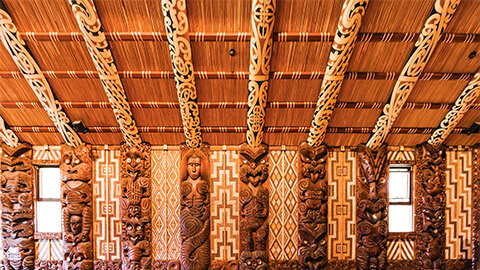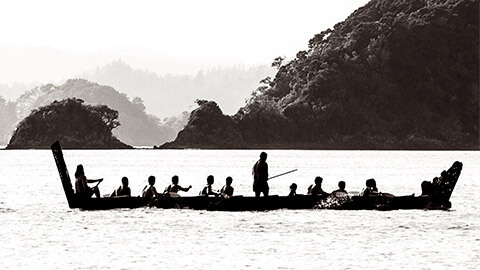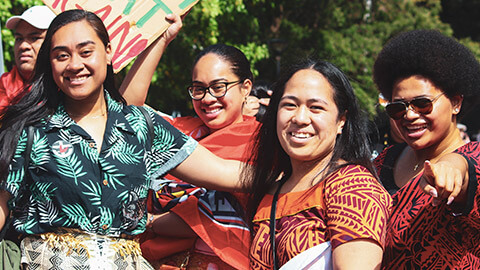A note on translations
Translations for Māori words are presented in brackets when they are first mentioned. You may wish to note any unfamiliar words and try to incorporate them into your daily life.
Many words do not have a direct translation into English and meaning may be lost. If you wish to explore the meaning of a word in more depth, Māori Dictionary has a wealth of knowledge online, via the app, or available as a book.
Context
As a creative marketer, you need to be aware of the social, cultural, and historical contexts in which you work. In the New Zealand context, this means understanding and respecting Māori and Pasifika values, honouring Te Tiriti o Waitangi – The Treaty of Waitangi, and learning about our history – the good and the bad.
Weaving values into the design process
For Māori, weaving together te ao Māori (Māori worldview), tikanga (process and practice), and mātauranga (knowledge) with their design process may provide whakamana (empowerment) and a sense of mana whenua (belonging). In the following video, artist Te Kuru o Te Marama Dewes discusses what it means to work in Māori media.
Pasifika peoples make up a significant part of New Zealand’s identity. In fact, Auckland is the largest Polynesian city in the world with close to 200,000 Pasifika peoples. For Pasifika peoples, art and design may provide a space to tell their stories, explore their identities, and connect to their culture. In the following video, Niuean-Māori artist Lina Marsh talks about how she uses art to explore contemporary Pacific culture.
For non-Māori, understanding and respecting Māori values is part of being a good treaty partner. Pākehā (New Zealanders of European descent) and Tauiwi (non-Māori, foreigners) have a duty under Te Tiriti o Waitangi (The Treaty of Waitangi) to respect the principles of partnership, participation, and protection. When embarking on the design process, consider how are you working in partnership with Māori communities? How are you encouraging participation and involvement of Māori? And how are you valuing and protecting Māori knowledge, values, interests, and taonga (treasures)?
Being a good ally and partner
Indigenous Design and Innovation Aotearoa (IDIA) have created a framework called Culture Centred Design (CCD). The framework ensures that design ‘outcomes are led, framed and informed by indigenous people, knowledge and ways of being’.1 The three strands that form the CCD are tāngata (people), mātauranga (knowledge), and tikanga (process and practice).
Non-indigenous designers need to understand their role as an ally and partner in design initiatives where indigenous context, knowledge or forms are core to the outcome, and to consider ways to avoid holding spaces where indigenous designers could be1
IDIA have also created a Cultural Integrity Scorecard made up of 12 yes or no questions assessing indigeneity, design, integrity, and authenticity. Design teams are encouraged to use this scorecard to assess appropriation and cultural awareness.
Take a moment to familiarise yourself with the Cultural Integrity Scorecard. Bookmark this resource to assist you when you are designing a brand, product, or service.
If your intellectual property includes Māori elements, your application may be referred to a Māori Advisory Committee.
Kaupapa Māori
Kaupapa are the fundamental beliefs or first principles. It incorporates the knowledge, skills, attitudes, and values of Māori society from a te ao Māori (Maori worldview.)
Kaupapa Māori is ‘Māori approach, Māori topic, Māori customary practice, Māori institution, Māori agenda, Māori principles, Māori ideology - a philosophical doctrine, incorporating the knowledge, skills, attitudes and values of Māori society’.2
Tikanga
Tikanga is the system of protocols observed within te ao Māori based on cultural traditions, practices, values, and beliefs. It can be translated as ‘correct procedure, custom, habit, lore, method, manner, rule, way, code, meaning, plan, practice, convention, protocol - the customary system of values and practices that have developed over time and are deeply embedded in the social context’.3
You can break down the word to deepen your understanding. ‘Tika’ means right or correct. The suffix ‘nga’ relates to the person responsible for implement the correct practice. Concepts of tikanga are constant, even though practices may vary between different iwi (tribes) and hapū (subtribes). For example, two different iwi may greet and welcome visitors in differing ways, but they both are meeting their responsibilities of manaakitanga (hospitality).
Kawa
Kawa are the protocols that operate on a marae, particularly formal protocols such as pōwhiri (welcoming) and mihimihi (introductory speeches). Kawa will determine who takes on a role and the way in which a ritual will occur.

Acknowledging that tikanga and kawa may look different for different iwi and hapū, we are going to consider kaupapa Māori as shared, fundamental Māori values. We will consider;
- Tapu (sacred, under protection) and noa (free of tapu, ordinary)
- Whanaungatanga (relationships)
- Whakapapa (genealogy)
- Rangatiratanga (leadership)
- Kotahitanga (unity)
- Manaakitanga (hospitality, kindness, support).
Tapu and noa
Tapu is to be sacred, prohibited, under protection from atua (the gods). Tapu is everywhere. It is in people, places, buildings, things, and words. In certain situations, people become more tapu – for example, women giving birth, warriors travelling to battle, men carving, and people when they die. Violation of tapu results in retribution. ‘Tapu was used as a way to control how people behaved towards each other and the environment, placing restrictions upon society to ensure that society flourished’.4
Water, food, and karakia (prayer, blessing) can remove tapu so things become noa (ordinary, not tapu). The process of removing tapu is called whakanoa.
Case study: Wellington on a Plate
In 2019, Wellington on a Plate was called out due to an advertising campaign featuring food being tipped over heads.
The head is tapu and food is noa. They should be kept separate. This is why hats should not be placed on tables, food should not be passed over heads, you should not sit on tables or pillows, and heads should not be cropped in images.
To tip food over heads is disrespectful, dangerous, and wasteful.
Case study: Christchurch Art Gallery
In 2020, a Christchurch art gallery apologised and removed controversial art after complaints of cultural appropriation of Māori culture. A painting by artist Rhonye McIlroy featured a white woman with a moko kauae, bare-breasted and wearing bondage.
Facial tāmoko is very tapu, sacred and the painting exploited, sexualised it, and used it in a derogatory way.
Case study: Kapiti Cheese
Kapiti Cheese named a cheddar after a famous Māori ancestor Tuteremoana. The naming and personification was disrespectful and caused hurt with descendants of Tuteremoana with children worried they would be eating their ancestor.
Again, this is an example of combining something tapu with something noa, and showing disregard for Māori values and people.
Whanaungatanga
People are taonga (treasures). A system of kinship includes the rights and reciprocal obligations that underpin the group. Whanaungatanga is about being part of a larger whole, the collective. Whanaungatanga is about knowing you are not alone. You have a community, whānau, hapū, and iwi that provide support, assistance, nurture, guidance, and direction when needed. Interdependence, not independence, is the goal.

Whakapapa
Whakapapa is to lay one generation upon the other.
A Māori sense of self draws from the whakapapa (ancestral connection and lineage, genealogy). We need to acknowledge that not all Māori know their whakapapa or reo (language), often because of injustices and historical trauma due to colonisation. This includes the 1955 Adoption of Children’s Act which saw thousands of Māori babies handed over to Pākehā families and all connection to the birth family severed.5 Connecting or rediscovering one's whakapapa can be an emotional and difficult journey.
A Māori approach to mihi (introductions, greetings) will start with a whakapapa. This approach helps to bridge and position who the speaker is in relation to the world known to the people listening. A mihi can be brief or can tell a longer, more comprehensive history.
A mihi can be part of a pepeha (formal introduction). It includes a reference to where your parents, grandparents, and ancestors are from. If a person has Māori lineage, the introduction will include specific geographical features such as maunga (mountain), awa (river), and waka their ancestors come from. The speaker’s ingoa (name) will usually come near the end of the mihi or pepeha.
You may come across pepeha templates featuring the phrase “ko ___ tōku maunga”. This translates roughly to “___ is my mountain.” Please be aware that this has a very specific meaning and links to ancestral roots. It is more than a mountain where you were born or grew up. It is more than a mountain that you enjoy spending time near or on. For Māori, introducing themselves using maunga and awa is stating their tīpuna (ancestors).
Rangatiratanga
Ranga is to weave, rangatira is the group, tanga is to draw from collective knowledge. Rangatiratanga is the strength of one’s own ability to lead or become a leader. Rangatiratanga is the expression of attributes a leader has, including humility, leading by example, generosity, selflessness, diplomacy, and knowledge of the benefit to the collective.

Kotahitanga
Kotahitanga is unity, togetherness, solidarity, and collective action. Developing and maintaining unity of purpose and a shared understanding of direction. Working in kotahitanga is to avoid approaches and decisions that lead to division and disharmony. Everyone is encouraged to contribute and express their opinions, but the group works together to reach consensus.
Manaakitanga
Mana is a supernatural force within a person and goes hand in hand with tapu. It encompasses authority, prestige, control, power, influence, status, spiritual power, and charisma. ‘Mana is the enduring, indestructible power of the atua and is inherited at birth, the more senior the descent, the greater the mana’.6 Mana can be enhanced by the view of others.
Manaakitanga is a combination of the words mana and aki (or akiaki) which is to lift up, build upon, strengthen. Manaaki is about acknowledging the reputation or status of others. An important note, that manaakitanga is not about self-promotion, it is about lifting up other people’s mana. Notice, recognise, and respond to other people in a positive manner. Take care not to trample another’s mana, instead choose to empower and uplift.
This can be interpreted as hospitality, kindness, and support. The process of showing respect and generosity for others.
Case study: Kono
Have a look at Kono, a Māori-owned food and beverage company in the South Island.
See how they incorporate their tikanga into Te Pae Tawhiti - their business plan. Te Pae Tawhiti is a 500 year plan and this forms a part of their marketing strategy. It is centred around their promise to the world - love for the land and respect for the sea – and together with their commitment to innovation, diversification, and strong relationships, it means they are here for the long haul.
Watch the video and see what Kono all is about.
Va – The space that relates
The va/va'a/vaha can be defined as the space that relates. Traditionally, for Pasifika people, sacred relationships exist between people as well as between people and the environment, ancestors, and the heavens.
The va is a pan-Pacific notion that describes the spatial and relational context within which secular and spiritual relationships unfold. Social, spiritual, and relational contexts allow for personal and collective well-being and growth through knowledge generation, social action, and cultural transformation. In Teu Le Va, relationships are given space and valued so that all involved may benefit.7
To nurture the va is to respect and maintain the sacred space, harmony, and balance within relationships.
Tapasā highlights nine Pacific values (Te Kete Ipurangi n.d.). This list is not exhaustive and may vary between different groups.
Reciprocity
Reciprocity is about mutual dependency, mutual benefit, and agreement. It is about equal interaction and sharing the same views. Mutual help, collective effort and interdependence are more effective than individualism.
Relationships
Relationships are of the utmost importance. In a Pacific context, this might be seen in the way Pacific people interact with each other, which often involves a lot of laughter and food.
Collectivism
Pacific peoples operate in a communal setting. The Pacific way of viewing the world is mostly driven by what is commonly perceived as acceptable to the community. This includes teamwork, consultation, and engagement with others in a collective manner, and is achieved by working together to achieve common goals and consensus.

Service
Pacific people love to help and often work well in collective settings. Service is a significant part of Pacific people’s lives at home, at church, or in the community.
Respect
Pacific people learn from an early age to show respect when relating to one another. This is expected behaviour. The concept of respect is often a reflection of their home environment, including showing respect towards elders, parents, women, children, and people in positions of authority. Respect includes acknowledging someone’s status and observing proper etiquette when speaking with people in positions of authority.

Spirituality
Pacific people value their spiritual faith and particularly the Christian faith, which is a vital part of their lives. Pacific people may feel uncomfortable if jokes are made about their faith, church, or spirituality. It is important to be mindful of this. Starting and ending the day with a prayer, and the blessing of food is important to many Pacific people.
Leadership
A common belief held by Pacific people is that in order to lead, one must follow. This aligns with the value of service. Pacific people may view leadership differently based on how they see leadership within their home and community contexts. It is important to embrace the diversity of what leadership may represent. Some Pacific people may be outspoken, while others embody the sense of humility.
Family
Some, but not all, Pacific peoples live in extended families. For most though, family is the centre of the community and their way of life. This brings a sense of identity and belonging. Pacific communities are collective; an individual will always identify themselves within the context of their families and wider communities. You will find many Pacific people put the interests of their families before their own.
Love
Love: a universal value, underpinning much of what all people do. In the Pacific context, it is the showing of care, kindness, and concern for others that drives Pacific people to prioritise family events or issues over their own needs and wants. For Pacific people, love is manifested through their actions, and particularly by putting others before themselves.
Your journey
We have introduced some Māori and Pasifika values. Understanding and learning about kaupapa Māori and Pasifika values is a long, personal journey and you are encouraged to continue exploring these topics.

